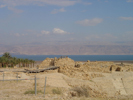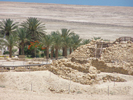Main Gate

Introduction
Khirbet Qumran is located on a plateau near the northwest shore of the Dead Sea, about 13 miles (20 km) east of Jerusalem, 9 miles (14 km) south of Jericho, and 20 miles (32 km) northeast of the Ein Gedi oasis. To the west and south of the ruins runs Wadi Qumran. To the east, beyond the Dead Sea can be seen the mountains of Jordan (in ancient times, Moab).
J. T. Milik, one of the first researchers at Qumran, described the journey to Qumran in 1959 in his Ten Years of Discovery in the Wilderness of Judea. To reach Qumran:
. . . the traveler leaves the Jerusalem-Jericho road when it comes out into the Jordan Valley and takes a macadamized road south-east to the north end of the Dead Sea. He then follows a rough track, which runs in and out of the wadis along the northwest coast of the Dead Sea for some four miles. On reaching the bed of the desolate Wadi Qumran he can see [the] ruins… (Milik, Ten Years, 47-48).
The buildings of the Khirbet Qumran site form a roughly rectangular structure. To the west of the rectangle lie a few additional installations. Although there is some debate concerning the relationship between the site and the scrolls found in the nearby caves, the overwhelming evidence seems to lead to the conclusion that occupants of Qumran were the authors of the sectarian literature found in the caves.
Both the scrolls and the geography support a picture of solitary exclusiveness. However, there has been recent recognition that the desolate, dry Judean desert and the deep caves of the Dead Sea region may not have been as isolated as scholars originally thought. (See Economic Life)
It is unlikely that the majority of the members of the Community of the Scrolls actually lived in the building complex of Qumran. Some of the nearby caves show signs of habitation, and it has been suggested that some sectarians may have dwelt in tents and huts, which have left only limited archaeological remains. De Vaux described the function of the main building complex at Qumran “not as a community residence but rather for the carrying on of certain communal activities.” It is possible that structural remains found at the nearby sites of Ein Feshkha and Wadi Ghweir also served as dwellings for members of the Community.
Several of the Qumran scrolls describe the process of admission to the Community, and the rules for assemblies of the Community. See Admission to the Community and the Assembly Hall tour.
More Info
- Millar Burrows, The Dead Sea Scrolls. New York: Viking, 1955.
- Magen Broshi and H. Eshel, “Residential Caves at Qumran,” DSD 6 (1996), 328-348.
- Philip R. Davies, George J. Brooke, and Phillip R. Callaway. The Complete World of the Dead Sea Scrolls. London: Thames and Hudson, 2002.
- J. T. Milik, Ten Years of Discovery in the Wilderness of Judea (trans. John Strugnell). Naperville, Ill: Allenson, 1959.
- Lawrence H. Schiffman, Reclaiming the Dead Sea Scrolls: The History of Judaism, the Background of Christianity, the Lost Library of Qumran. ABRL. Philadelphia: Jewish Publication Society, 1994.
- Yigael Yadin, The Message of the Scrolls. New York: Simon and Schuster, 1957.

